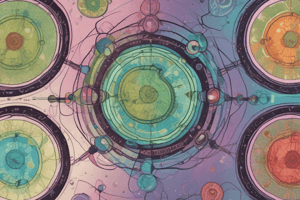Podcast
Questions and Answers
During which phase of the cell cycle is DNA replicated?
During which phase of the cell cycle is DNA replicated?
Which phase of the cell cycle accounts for the longest duration?
Which phase of the cell cycle accounts for the longest duration?
What happens if a cell does not meet all requirements during the G1 phase?
What happens if a cell does not meet all requirements during the G1 phase?
Where in the cell cycle do cells decide whether to proceed with mitosis or enter a resting state?
Where in the cell cycle do cells decide whether to proceed with mitosis or enter a resting state?
Signup and view all the answers
Which stage of the cell cycle involves dividing DNA and cellular materials among daughter cells?
Which stage of the cell cycle involves dividing DNA and cellular materials among daughter cells?
Signup and view all the answers
What is the primary purpose of the G2 phase in the cell cycle?
What is the primary purpose of the G2 phase in the cell cycle?
Signup and view all the answers
During which stage(s) of mitosis do the sister chromatids separate and move to opposite poles of the cell?
During which stage(s) of mitosis do the sister chromatids separate and move to opposite poles of the cell?
Signup and view all the answers
How do plant cells and animal cells differ in the process of cytokinesis?
How do plant cells and animal cells differ in the process of cytokinesis?
Signup and view all the answers
What is the primary purpose of the S phase in the cell cycle?
What is the primary purpose of the S phase in the cell cycle?
Signup and view all the answers
What is the primary function of the centrosome during the cell cycle?
What is the primary function of the centrosome during the cell cycle?
Signup and view all the answers
Study Notes
Understanding the Cell Cycle: An Overview
The cell cycle is a fundamental biological process that leads to the production of two genetically identical daughter cells. It is divided into two major phases: interphase and the mitotic phase (mitosis and cytokinesis). During interphase, the cell grows and prepares for division. Specifically, DNA is replicated, and the cell grows in size and generates necessary materials for the coming cell division. Once these preparations are done, the cell enters the mitotic phase, where DNA and cellular materials are divided among the two daughter cells.
Interphase
Interphase is the longest phase of the cell cycle, accounting for nearly 95% of the total duration. This phase consists of three distinct stages: G1 (first gap), S (synthesis), and G2 (second gap). During interphase, the cell grows and accumulates building blocks for DNA replication. It is during this phase that cells decide whether to proceed with mitosis or enter a resting state called G0, where they cease growth and have reduced rates of protein synthesis until further stimulation arrives.
G1 Phase
The G1 phase marks the beginning of interphase, characterized by cellular activities such as nutrient uptake, protein synthesis, and organelle duplication. A cell that does not meet all requirements will halt at the G1 checkpoint and may try to remedy the problematic condition before moving on to the next stage. If conditions improve, the cell can continue into G2; otherwise, it enters quiescence (G0) and awaits additional signals.
S Phase
During the S phase, also known as the synthesis phase, nuclear DNA replication occurs, resulting in the formation of two identical copies of each chromosome—sister chromatids—that are attached by a centromere. The centrosome (the microtubule-organizing structure) is also duplicated, which helps separate DNA during M phase.
G2 Phase
In the G2 phase, the cell grows further, produces proteins and organelles, and begins to reorganize its contents in preparation for mitosis. The cell ensures that proper conditions are met before transitioning into mitosis at the G2 checkpoint, where it checks cell size and protein reserves. At this stage, a decision is made to proceed with mitosis or enter quiescence (G0) if conditions are not favorable.
Mitotic Phase: Cell Division
Mitosis
The mitotic phase consists of two primary stages: mitosis and cytokinesis. Mitosis involves the condensation of chromosomes, attachment to spindle fibers, movement to the center, and separation into new cells. It can be divided into four main stages: prophase/prometaphase, metaphase, anaphase, and telophase. During these stages, sister chromatids separate, reform nuclear envelopes, and attach to spindle fibers that pull them apart.
Cytokinesis
Cytokinesis follows mitosis and signifies the division of the cytoplasm among the two daughter cells. In animal cells, this process occurs through contractile ring contraction, which pinches the cell in two to form two new cells connected by a cleavage furrow. Plant cells divide differently; they build a cell plate down the middle of the cell, creating two distinct cells separated by a cell wall.
In summary, the cell cycle is a highly regulated series of events involving DNA replication, cell growth, and division. Interphase prepares the cell for the mitotic phase, where DNA and cytoplasmic contents are separated among the two new cells formed during cytokinesis. The whole process is tightly controlled by various checkpoints and feedback mechanisms to ensure accurate and efficient division.
Studying That Suits You
Use AI to generate personalized quizzes and flashcards to suit your learning preferences.
Description
Test your knowledge on the cell cycle, a fundamental biological process that leads to cell division and the production of genetically identical daughter cells. Learn about the phases of the cell cycle, including interphase (G1, S, G2) and the mitotic phase (mitosis and cytokinesis). Explore how cells grow, replicate DNA, and ensure accurate division through various checkpoints.




